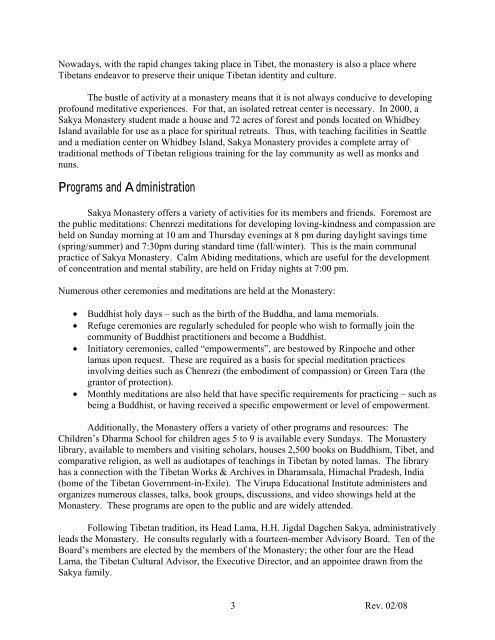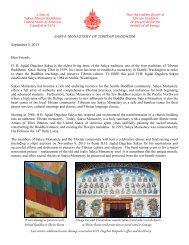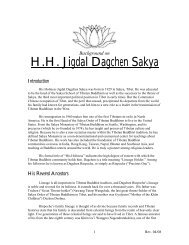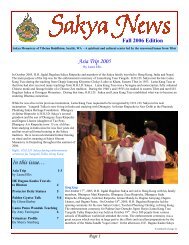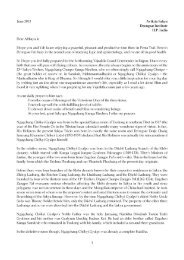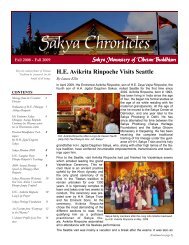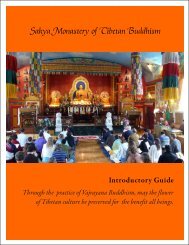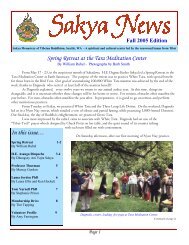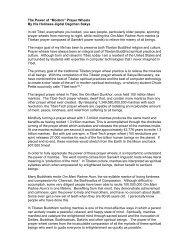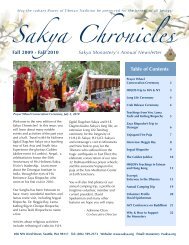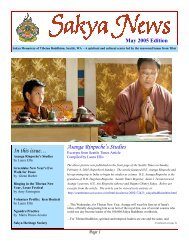Sakya Monastery.pdf - the Sakya Monastery of Tibetan Buddhism
Sakya Monastery.pdf - the Sakya Monastery of Tibetan Buddhism
Sakya Monastery.pdf - the Sakya Monastery of Tibetan Buddhism
You also want an ePaper? Increase the reach of your titles
YUMPU automatically turns print PDFs into web optimized ePapers that Google loves.
Nowadays, with <strong>the</strong> rapid changes taking place in Tibet, <strong>the</strong> monastery is also a place where<strong>Tibetan</strong>s endeavor to preserve <strong>the</strong>ir unique <strong>Tibetan</strong> identity and culture.The bustle <strong>of</strong> activity at a monastery means that it is not always conducive to developingpr<strong>of</strong>ound meditative experiences. For that, an isolated retreat center is necessary. In 2000, a<strong>Sakya</strong> <strong>Monastery</strong> student made a house and 72 acres <strong>of</strong> forest and ponds located on WhidbeyIsland available for use as a place for spiritual retreats. Thus, with teaching facilities in Seattleand a mediation center on Whidbey Island, <strong>Sakya</strong> <strong>Monastery</strong> provides a complete array <strong>of</strong>traditional methods <strong>of</strong> <strong>Tibetan</strong> religious training for <strong>the</strong> lay community as well as monks andnuns.Programs and Administration<strong>Sakya</strong> <strong>Monastery</strong> <strong>of</strong>fers a variety <strong>of</strong> activities for its members and friends. Foremost are<strong>the</strong> public meditations: Chenrezi meditations for developing loving-kindness and compassion areheld on Sunday morning at 10 am and Thursday evenings at 8 pm during daylight savings time(spring/summer) and 7:30pm during standard time (fall/winter). This is <strong>the</strong> main communalpractice <strong>of</strong> <strong>Sakya</strong> <strong>Monastery</strong>. Calm Abiding meditations, which are useful for <strong>the</strong> development<strong>of</strong> concentration and mental stability, are held on Friday nights at 7:00 pm.Numerous o<strong>the</strong>r ceremonies and meditations are held at <strong>the</strong> <strong>Monastery</strong>:• Buddhist holy days – such as <strong>the</strong> birth <strong>of</strong> <strong>the</strong> Buddha, and lama memorials.• Refuge ceremonies are regularly scheduled for people who wish to formally join <strong>the</strong>community <strong>of</strong> Buddhist practitioners and become a Buddhist.• Initiatory ceremonies, called “empowerments”, are bestowed by Rinpoche and o<strong>the</strong>rlamas upon request. These are required as a basis for special meditation practicesinvolving deities such as Chenrezi (<strong>the</strong> embodiment <strong>of</strong> compassion) or Green Tara (<strong>the</strong>grantor <strong>of</strong> protection).• Monthly meditations are also held that have specific requirements for practicing – such asbeing a Buddhist, or having received a specific empowerment or level <strong>of</strong> empowerment.Additionally, <strong>the</strong> <strong>Monastery</strong> <strong>of</strong>fers a variety <strong>of</strong> o<strong>the</strong>r programs and resources: TheChildren’s Dharma School for children ages 5 to 9 is available every Sundays. The <strong>Monastery</strong>library, available to members and visiting scholars, houses 2,500 books on <strong>Buddhism</strong>, Tibet, andcomparative religion, as well as audiotapes <strong>of</strong> teachings in <strong>Tibetan</strong> by noted lamas. The libraryhas a connection with <strong>the</strong> <strong>Tibetan</strong> Works & Archives in Dharamsala, Himachal Pradesh, India(home <strong>of</strong> <strong>the</strong> <strong>Tibetan</strong> Government-in-Exile). The Virupa Educational Institute administers andorganizes numerous classes, talks, book groups, discussions, and video showings held at <strong>the</strong><strong>Monastery</strong>. These programs are open to <strong>the</strong> public and are widely attended.Following <strong>Tibetan</strong> tradition, its Head Lama, H.H. Jigdal Dagchen <strong>Sakya</strong>, administrativelyleads <strong>the</strong> <strong>Monastery</strong>. He consults regularly with a fourteen-member Advisory Board. Ten <strong>of</strong> <strong>the</strong>Board’s members are elected by <strong>the</strong> members <strong>of</strong> <strong>the</strong> <strong>Monastery</strong>; <strong>the</strong> o<strong>the</strong>r four are <strong>the</strong> HeadLama, <strong>the</strong> <strong>Tibetan</strong> Cultural Advisor, <strong>the</strong> Executive Director, and an appointee drawn from <strong>the</strong><strong>Sakya</strong> family.3 Rev. 02/08


